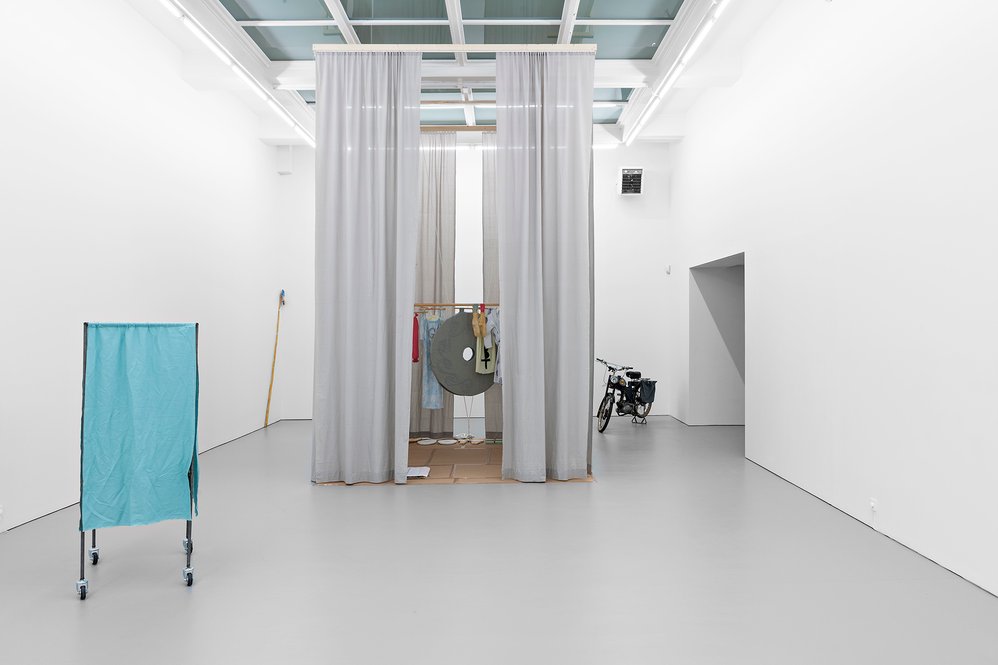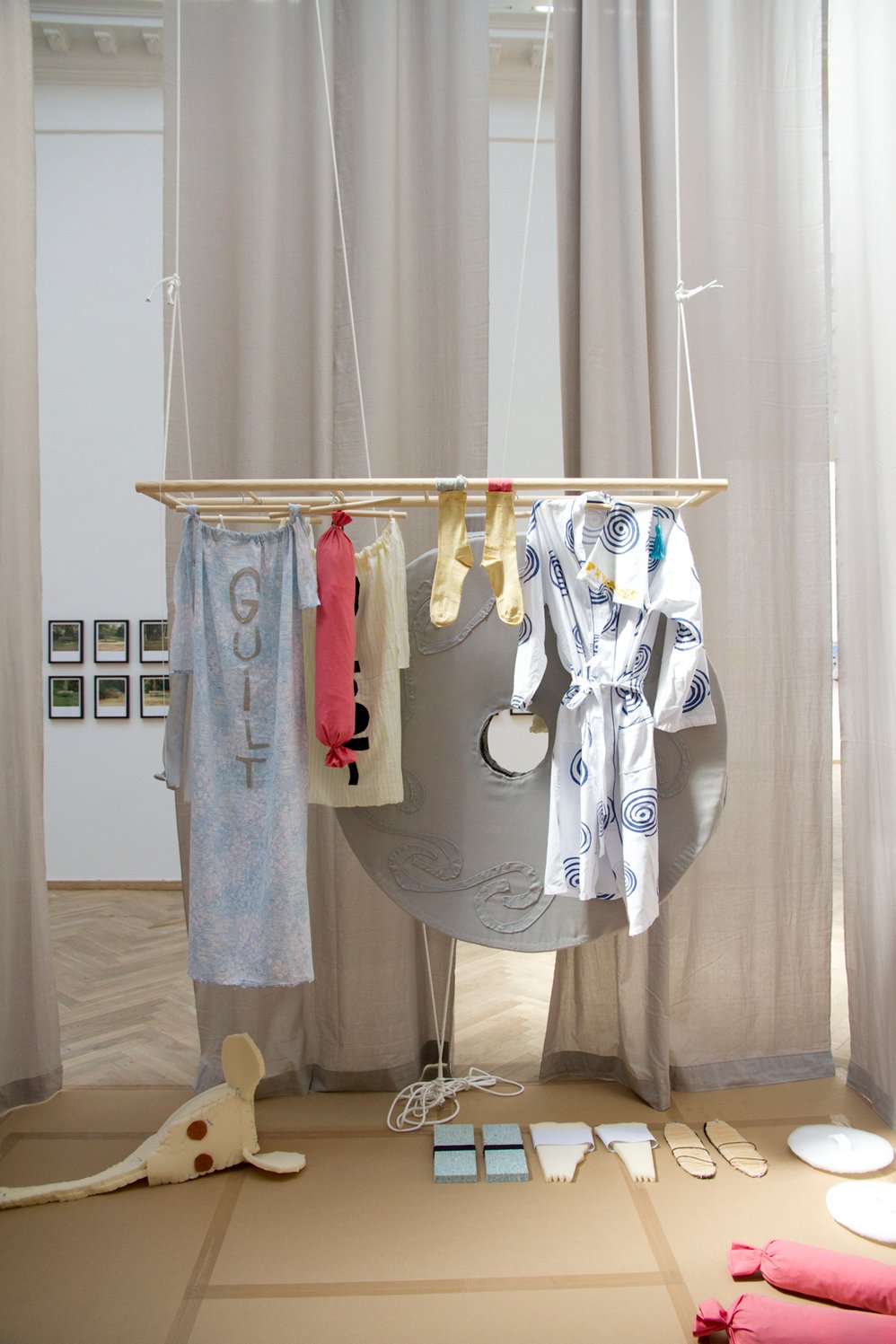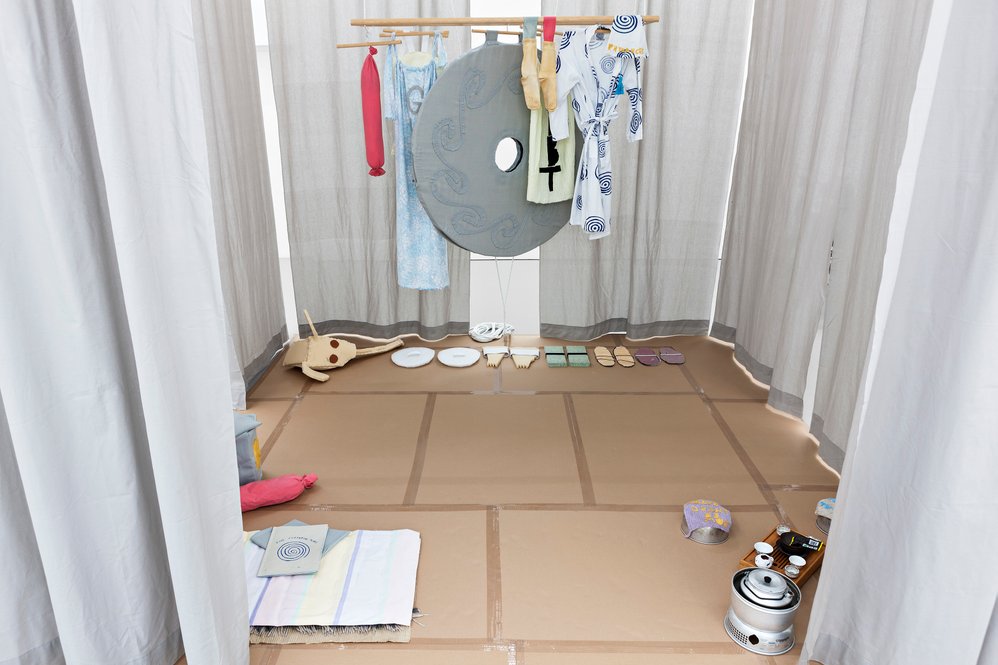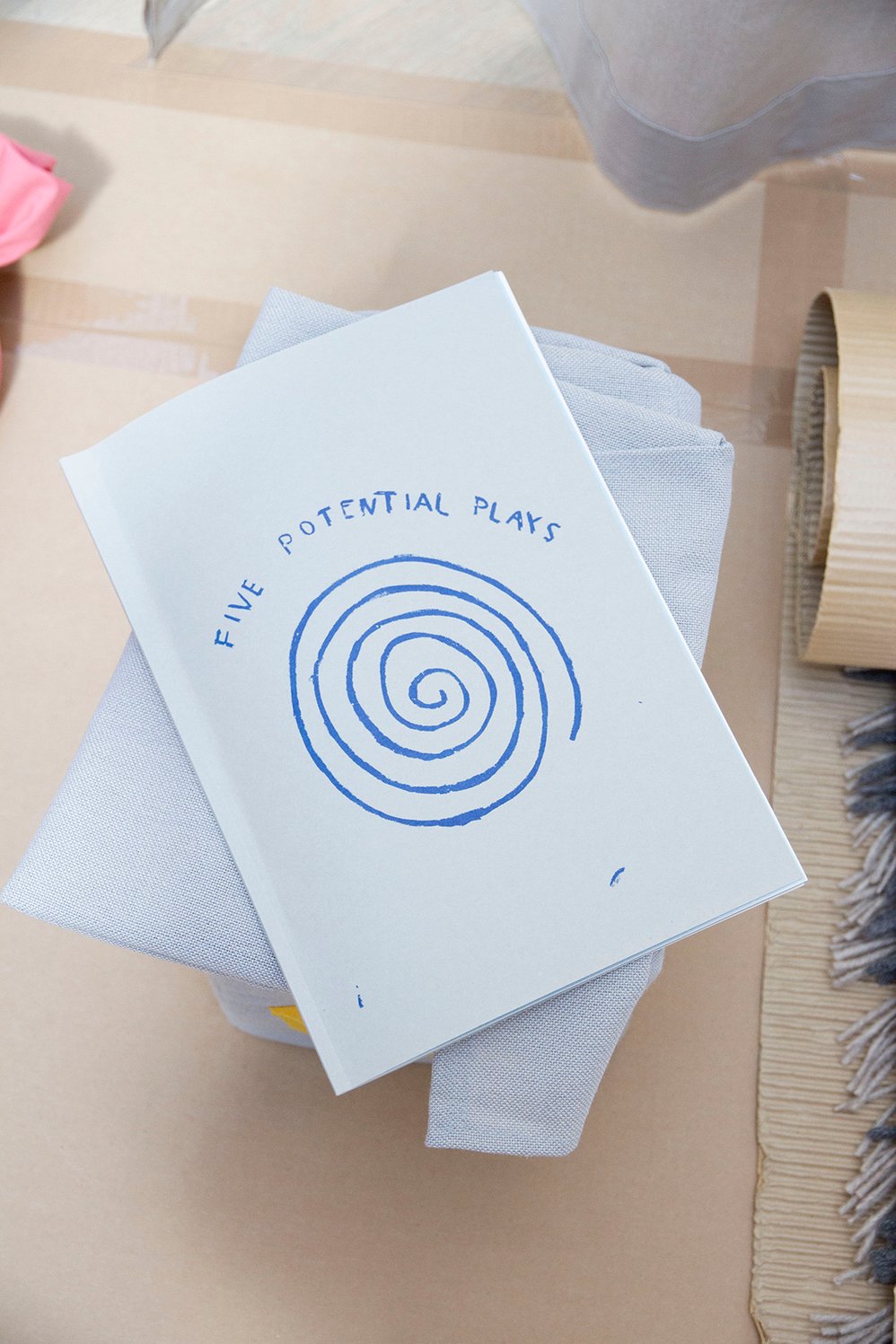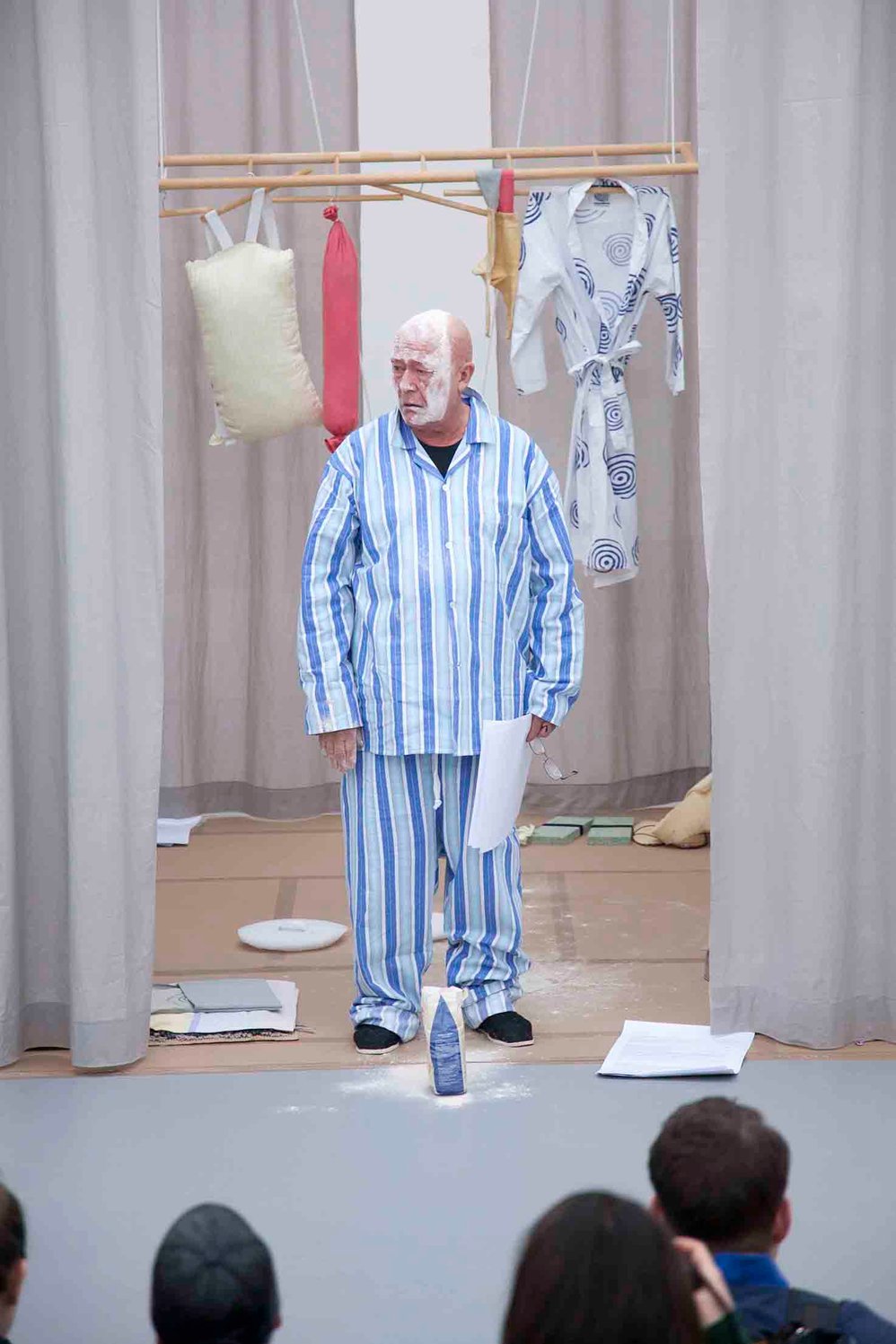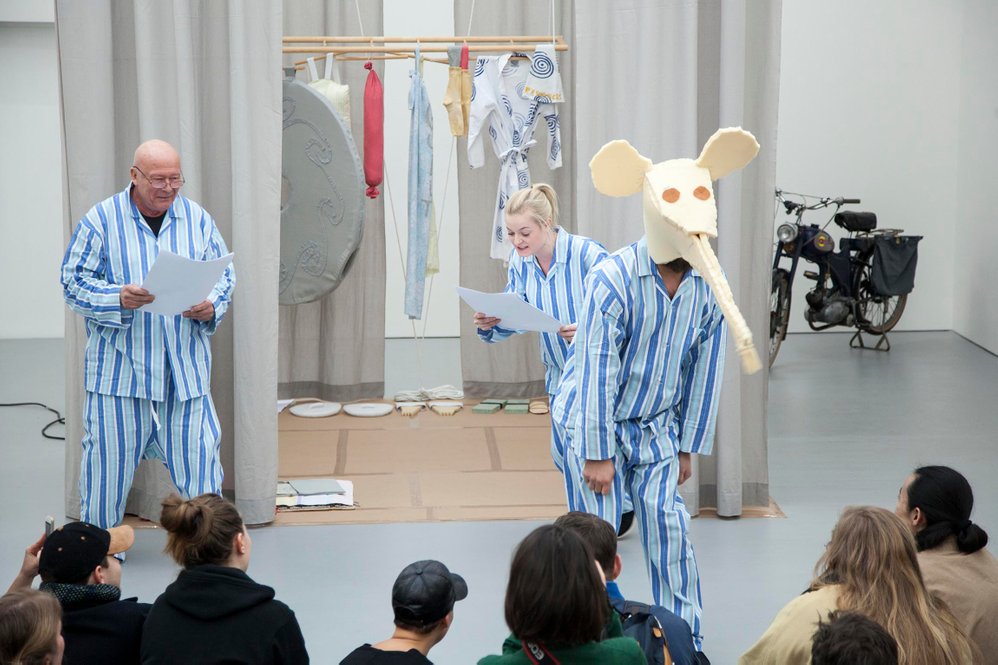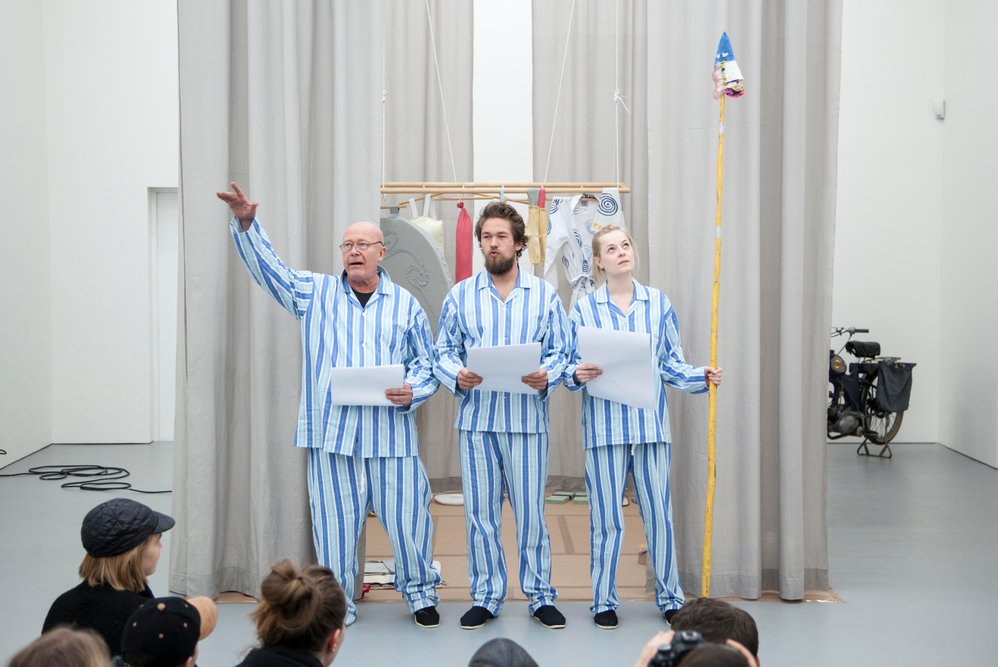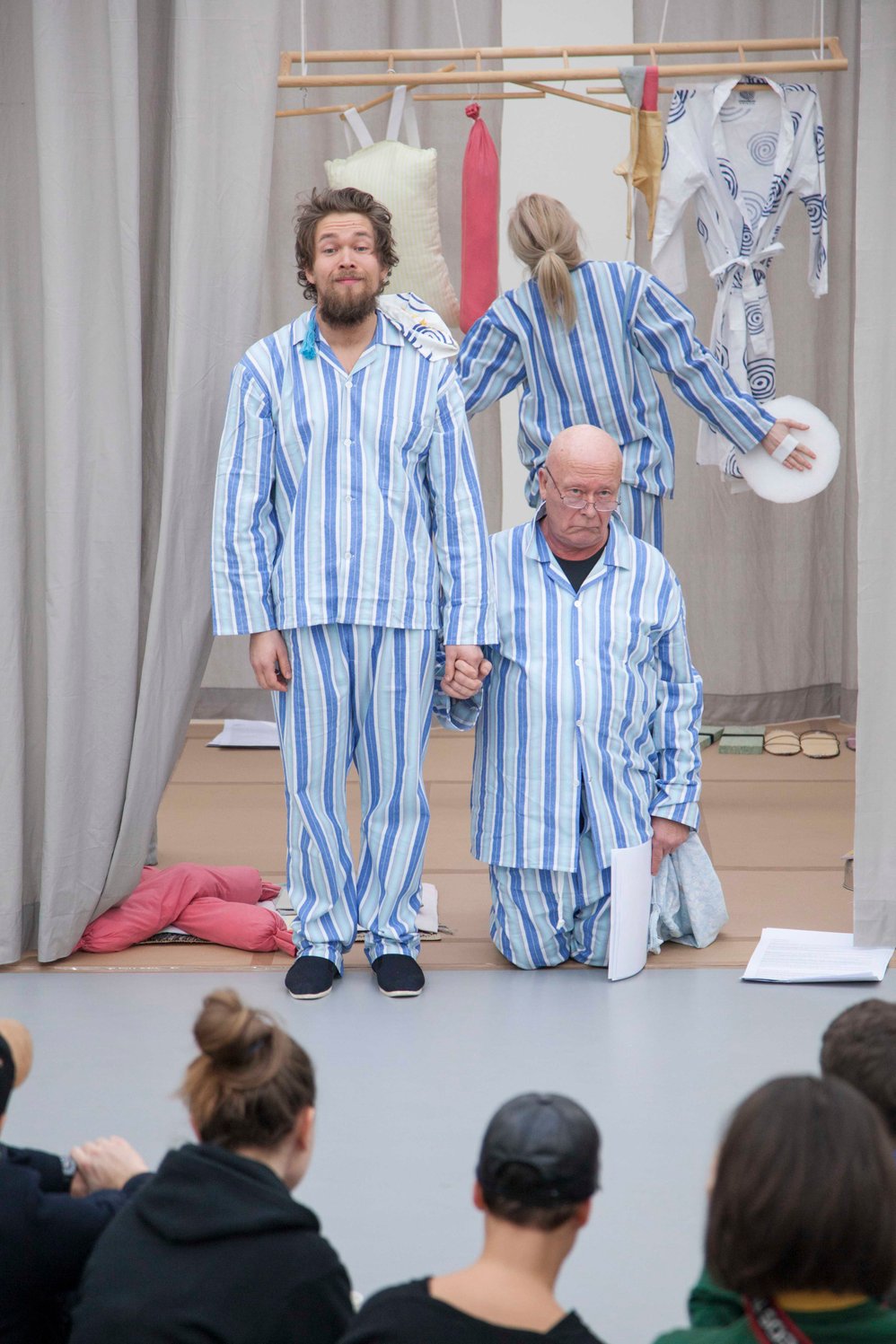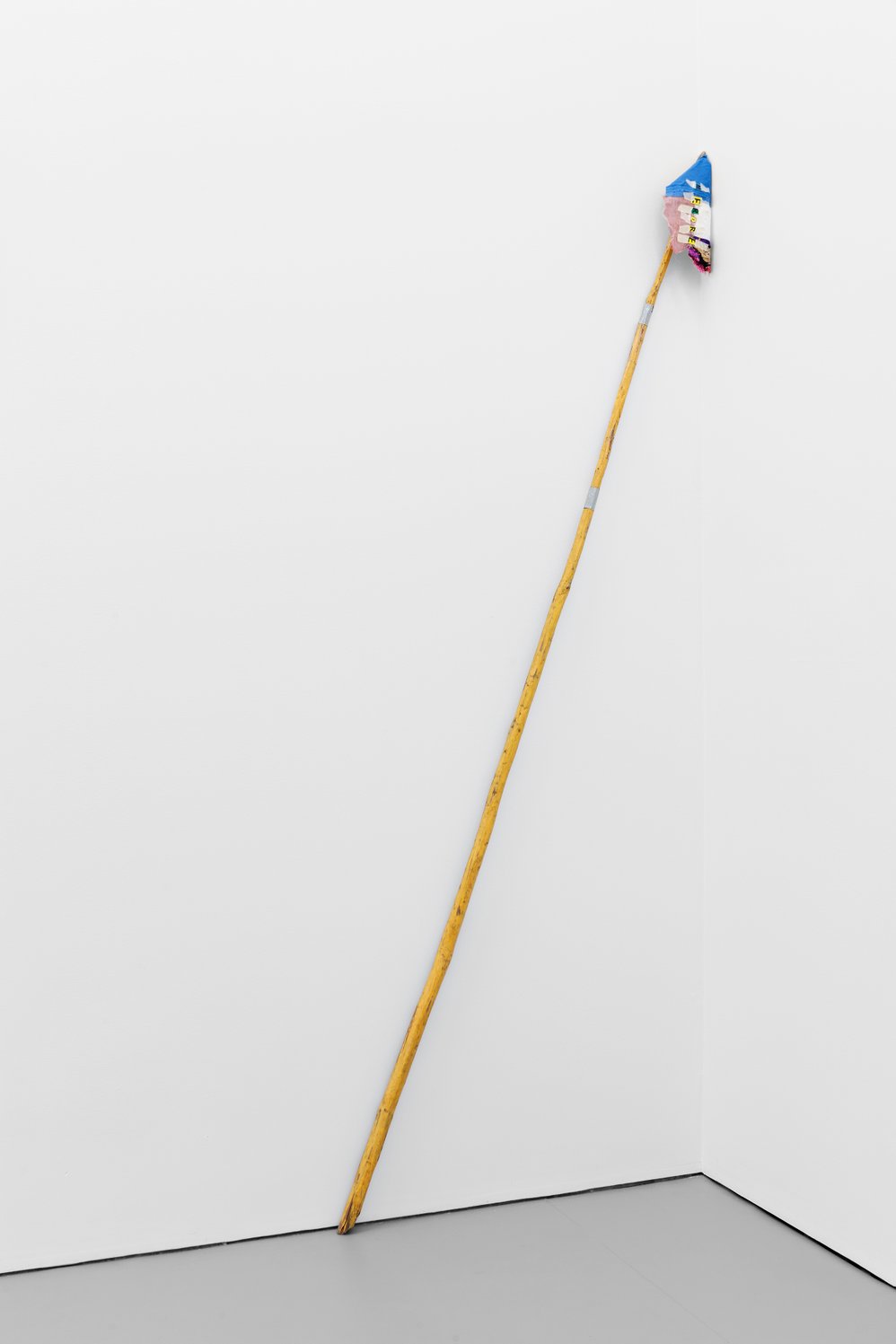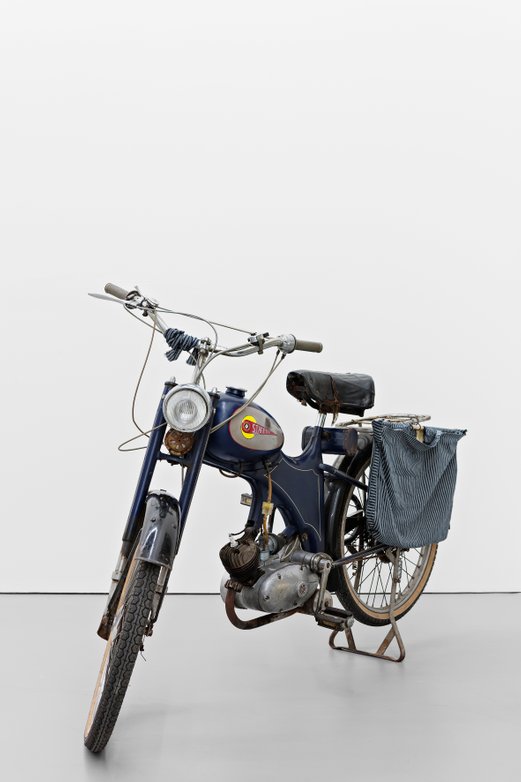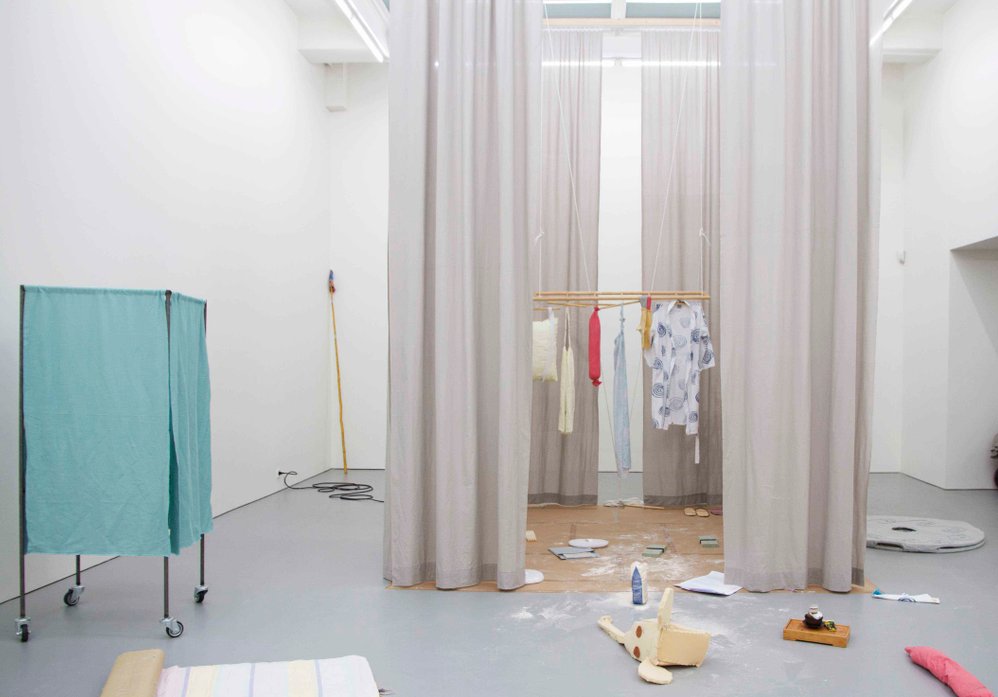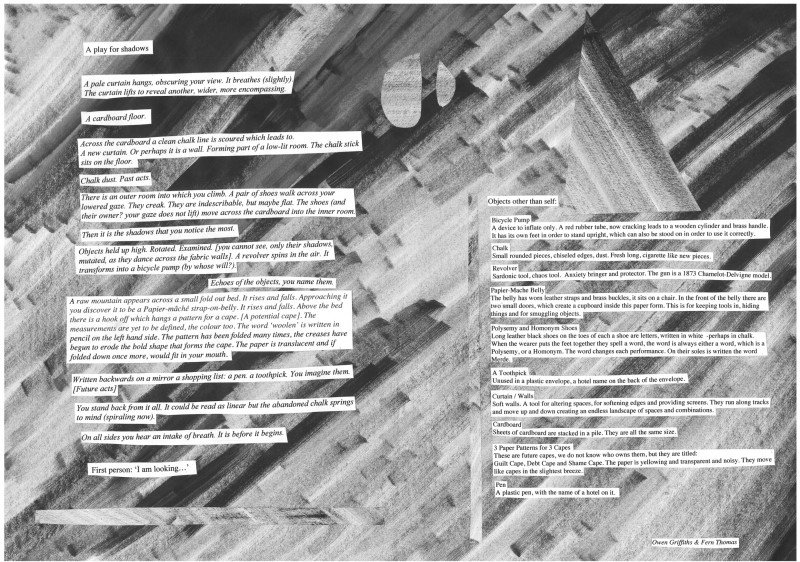CONSTRUCTIONS AND DESTRUCTIONS: A POTENTIAL PLAY. 2014/15
Installation/Play.Dim Variable.
SHOWN/PERFORMED AT: KUNSTHAL CHARLOTTENBORG DK, YOUNG ARTIST SOCIETY UKS NO, MOMA PS1 USA.
FIVE POTENTIAL PLAYS:
KASPER HESSELBJERG
hi friends!
I have talked to most of you a little bit about writing something for my exit work. text for the catalogue and the same text repeated in a small publication.
I thought it easier to write a collective mail now and then we can talk in smaller groups and one to one later.
My work for exit as some of you know has the working title:
Constructions and Destructions: A potential play.
Its gonna be a quite big installation, there will be a room/space created by grey fabric hanging down from the ceiling, around one of the big ceiling windows in Charlottenborg. It will be a slightly transparent fabric, but hopefully most of the light will be defined from the natural light from the window.
The fabric will create a closed space a sort of column, but it will be a soft architecture,
some times one, two or all of the fabric walls will/can be rolled up in various hights, opening up the space, transgressing the boarders between it and the rest of the exhibition space.
The floor in the room/stage/space will most likely be made out of cardboard, to make a shift in the body, again this soft architecture and also refer to and work as isolation hinting at a transformation, something being constructed/changed.
The play will be made from my side by the spacial structures and objects, inside and outside this space.
Here are a list of characters in the play so far(with some notes):
the bed(foldable-into a spiral)
the moped(testosterone, the external, also desire object, movement)
the ceiling window(natural light, makes the rooms inside to an outside)
the walls(fabric, soft architecture, ref eileen gray, also IChing and this idea that there are no black and white only shades of grey)
the floor(cardboard, nomadic, isolation)
the tea set(also cups by kasper)(friendship everyday ritual, phenomenological,water flowing)
the suit(the flaneur, also a tool for acceptance/access in many otherwise inaccessible spaces, especially for women)
the coin costume(phynanses)
the socks(portable carpet for our feet)
the shoes("stable" surfaces that makes us able to easier, some times the opposite and often the case with women's shoes, move around in the world)
Capes (a superhero a cape like children that put a towel around their neck and run around-movement, but here capes of guilt, debt, socks)
Ubu Roi costume(the childish, the greedy, the bourgeois, the bucket hat, the spiral spa bathrobe, yellow socks)
tassel(s) both a decadent western decoratif and in the east a spiritual object,a charm bring luck etc
(rocks-emotions)
the anti surveillance tool(hospital bed deviders, rullator relations)
the sausage(factory)
the rat (very social,likes to be tickled, the most common rat is called rattus norvegicus, in china its a symbol for money-success, sometimes a symbol of resistance-union workers new york-the inflatable scabby the rat, sometimes a symbol of the corrupt, all might be in connection or maybe also be in contradiction)
music (experiments) made by jonas frederiksen
some other notes and words:
inter human relations- groups-energies reacting/ connecting
constructions(power relations-social structures-identity)-clothes, possessions
the importance on the destructive, possible new beginnings. the crisis, building out of the ruins, a possible new structures?
theatre? performance? enactment?
soft architecture- the layers membranes
clothes(the sensual membrane that are between our bodies and the world) walls, floor, socks, shoes
the sensual membrane that are between our bodies and the world.
(the importance of)rituals in the everyday life
friendship
tea-friendship-the phenomenological, the liquid running through and around the body
the things we own, that follow us around, an I made up by objects, relations-forming identities.
Ok, maybe its a lot of stuff. but I was thinking if you each of you would like to write a small potential play based on these things, and our conversations and how you know me etc.. It can be as long or as short as you like include some of the elements or maybe even none, open up to subjects that you are interested in.
It can have any form you like..I don't know how a theatre play should look on paper. but I like to call it a play, as a sort of relation between characters (in an extended sense- here also"objects")
It can be in english or danish or spanish or chinese
let me know how you feel, and lets discuss and play with ideas thoughts etc and develop it further, write me if you had questions, critique, thoughts etc.
looking forward to see what will happen.
yes and on a practical note: the current deadline for the catalog is april 10th. I hope thats not too tight with time.
some links
http://en.wikipedia.org/wiki/Guy_de_Cointet
http://www.ubu.com/film/foreman_city.html
http://www.ubu.com/film/jarry_ubu-averty.html
`Pia
Hi Again.
I realize after talking to some of you that Im probably not always the best at communication information very clearly.. so I thought to just elaborate a little.
What I was thinking was that all of you each write a kind of a (potential)play.
That gives 5 different perspectives on the relations between the characters that I mentioned below(above), also my idea of a character in a play here is more abstract. It can be an object, the iceberg(ref gertrude stein) a person and so on. I imagined somehow that you would use some, one or all of the characters that I created and write a play(and creating potential relations between them), but you can also use it as a way to write/focus on a subject that you are interested in, architecture, gender, tea, phenomenology, sci fi, pataphysics, collectivity and so on...
For me its more a way of creating/producing knowledge and relating my work to you and showing how what we/I do is part of a bigger collective discussion, sharing ideas and discussing idea and interests with friends.
I will try to send images of the characters as I produce them, for now a few images of old socks, a flag of shit and a bed.
`Pia
“The Potential of Play”
- A potential play
by Anna Ørberg
Characters:
1
2
3
and a long flag of shit (merdre)
Scene 1
A raft on open water covered by a tent.
It is very hot.
The three characters are seated on the hard floor of the raft.
1: Oh dear lord, the heat is killing me, how long must we suffer in this post-apocalyptic gate to hell. All ground beneath us has been swallowed by the wave and we are left to die from thirst or worse!
2: My friend, I suffer too, but we shall not let ourselves be defeated by the regime of the catastrophe, let us at least continue fighting!
1: But my head is heavy, my arms too much of a burden to carry around, I see no reason to continue, all there is left to live for is misery and misfortune. Can we even call this a life?
3: My dear friend, raise your spirit, at least we have each other!
2: Exactly! I wouldn’t dare to think of being alone on this godforsaken raft with nothing but rats and my increasing insanity.
1: But dear comrades, do you not know of the inevitable ending to this tale - we shall end up murdering each other, eating the corpse of the first one to go. All ethics and morals aside - at the end of the day, who can deny bodily needs?
3: What bodily needs do you speak of? I know only one need and that is comradeship, and what you are talking about are lessons of consumption from the old world!
2: Yes, speak for yourself, I would rather eat my own sluggish arm than hurt my fellow sufferers.
3: And I would go as far as eating my own feces rather than dive into this exploitation of others. Which might happen sooner rather than later considering I really have to go!
1: Hold on, that is not a bad idea at all my friend, we could live off shit and friendship, think of all that nutrition...
2: What a brilliant idea, we could be completely self-sufficient out here. Our shit will be the fertilizer that would maintain our existence - we will not decrease for demands of growth, only maintenance is our goal!
3: We shall be the pioneers of the new world of shit!
1 takes the stick of shit (merdre flag) and waves it.
1: Hail the new world of shit!
3: (Laughing) Haha, you do know that it is not possible to live off shit, right?
2: (Also laughing) Hahaha, but of course, that is not healthy at all!
1: (Joins the laughter) Haha, no but we are just playing are we not? Eating our own feces would kill us surely, but we are going to die anyway, hahaha!
All continue laughing.
3: Yes we are all gonna die - but it is nice to have a laugh about it, if nothing less:) Shitting and laughing and playing shall be the driving force of our new world, hahaha!
1: (still waving the flag) Hahaha, oh stop it already, my stomach aches from all the laughter and joy :-D
2: Hahaha, oh tell me about it dear comrade, I think I just shat my pants, oh lord, it is hilarious!
3: Hohoho, me too - all this talk of shit, I cannot hold it back!
Suddenly the raft starts leaving the ground. All cease to laugh.
1: What the heck, this raft of ours is taking off, do you not feel it too?
3: I feel it! We are flying - it must be all the gasses! It has caught on to the flag of shit and now we are taking off, fighting hot air with hot air, who could have guessed...
2: Indeed, this is happening, we might just survive! Praise the potential of play!
1: Praise the potential of laughter!
3: And praise the potential of shit!
All in unison, waving the flag, singing:
Praise the potential of play! Praise the potential of laughter! Praise the potential of shit!
All characters continue playing after the curtain falls.
Flaneuren af: Kristian Byskov
Scenen er sat i Kunsthal Charlottenborgs udstillingsrum. Der er et glas sort læskedrik (50 cl) på et lille, rundt cafébord i rummet, omkranset af fire stofvægge, der tilsammen danner et nyt rum i midten af udstillingsrummet. Det er i dette nye rum stykket udspilles.
Flaneuren er en person af valgfri alder og udefineret køn. Klædt i Flaneurens Dragt. Sminket hvid i ansigtet med buskede, hvide øjenbryn. Panden er rynket i en bekymret mine.
Flaneuren er placeret ved siden af en stofvæg, med sin højre skulder mod den, cafébordet stående tæt på sin venstre side.
Publikum er placeret på samme side af stofvæggen, med front mod Flaneuren.
Hvilken stofvæg, der vælges er irrelevant.
Stykket kan kun opføres én gang i dette rum.
[Flanueren læner sig let over cafébordet og tager glasset i sin hånd. Ånder dybt ind før første replik.]
- Ved et udsigtspunkt i byen satte jeg mig på en stol, da den stod i skyggen af en parasol. For dette måtte jeg konsumere et eller andet. I den rette ånd for situationen bestilte jeg en Coca Cola, som for at søge efter mit begær med syntetisk læskedrik, som for at rive skorpen af såret, som for at fortælle alle andre (for jeg ved I kigger) at: Ja, jeg er med i det her, vi er i det sammen, og jeg kæmper også forgæves.
[Nipper let til glasset med læskedrik. I løbet af næste replik nipper Flaneuren til sin drik med jævne mellemrum.]
- Jeg er Flaneuren, nomaden i byen. Jeg lever for at fare vild og i desorienteringens øjeblik improvisere med øjnene og danne
betydninger, der kan bryde koderne i griddet; i byens vævede system af vener og årer, krydser jeg strømmen.
[Tømmer glasset i et drag. Stiller det fra sig på bordet, lader det ramme højlydt.]
- For at sige sandheden går det ikke godt for tiden. Man tror det er nemt at lade handlinger ske ved passivt at bruge af rummet i farten, men det er som om jeg altid bliver indhentet – bruget bliver forbrug og jeg forbruges i gadernes og kroppens behov for begær, som skifter med hvert skridt jeg tager.
[Kigger på stofvæggene.]
- Her i byen tørrer folk deres tøj udenfor. Hvis vejret er godt. De dage det regner undlader man at
vaske. Men i dag er solen fremme, og gaderne dufter af vaskepulver, og stof hænger lodret langs med murene.
[Rører ved stoffet.]
- Det er tyndt og blødt. Det foldes og danner lag. Det bevæger sig i vinden. Det har en duft. Som struktur eller ekstra arkitektur bærer det en lethed, som selv min egen skrøbelighed kaldes frem af.
[Løfter et stykke stofvæg over hovedet så det er helt dækket, og resten af
stofvæggen hænger ned ad Flaneurens krop.]
- Ah.
[Snuser ind.]
- Man kan ånde igennem det. Åbner jeg øjnene kan jeg også ane silhuetter af lys og bevægelser. Det er her, i dette nære perspektiv, at den bløde væg ses som et net af utallige tråde, flettet ind i hinanden i et altdominerende system. Et grid af orden. Hvis en enkelt tråd er lagt forkert bliver det samlede
netværk skrøbeligt og stoffet kan ikke holde sammen, ophører næsten med at være stof. Selvom det er blødt er det stadig hårdt, og selvom jeg består af skrøbelige væsker og væv, er jeg stadig stiv i marven. Og med griddet lagt stramt over mit hoved...
[Hiver ned i stoffet så det strammes over hovedet. Strammer gradvist mere og mere mens monologen fortsætter.]
- ...kan jeg mærke jeg kvæles i en tryghed, jeg selv har søgt ind til.
Mit begær er for systemer og min frihed er sort, syreholdigt sukkervand, for jeg har slugt rotten og den bor i min mavesæk, skider i min tarm, lever af læskedrik og gnaver langsomt et mavesår i et nervøst, neurotisk væv, jeg er gjort af. Jeg er skrøbelighed, blot holdt oprejst af min rygsøjles fastgørelse til mit bækken, men jeg er skrutrygget, falder altid sammen over mig selv; på militant vis marcherer jeg med strakte ben, et, to, et, to, hen mod stolen, med parasolen, og
lader som om jeg ignorerer den person, der så mig allerede før jeg kom, som er ivrig, på akkord, og jeg lader rotten ridse i min indre mavesæk med sine fortænder, pelsløs, for den er badet i sort syre, og den skriger af fryd idet jeg bestiller en til: ”Et, to, et, to, et.” Og...
[Gylper sort læskedrik op af maven, lader det sive igennem stofvæggen, der stadig holdes stramt over hovedet. Flaneuren hoster og sprutter, som man gør. Bukker til bifald. Slipper stoffet og retter det til,
så det hænger som før. Det vil fortsat hænge på scenen, med pletten, til udstillingen lukker.]
A Synchronic Play For 6
by Margarita del Carmen
This play is a series of acts that conforms a ritual defined by the actors and the situation, where the instructions interweaves with improvisation creating a choreography of sounds and movements.
The play is divided in three acts. Each one is an interval of 6 minutes. In each shift, the actors change their positions, rhythm of movements and sounds to a new order.
The scene is heavily filled with humidity and steam. The room has a smell of cooked vegetables, tea and sweat. There are four curtains in the room that form a new room. These curtains goes from ceiling to floor and are semi-transparent.
The illumination is dim, with a whitish tone.
The sound of the room is a full salon of whispering people.
The audience are told to imagine 2 places within the same stage. A dead-end street (the Rat, the Flaneur and the Moped). A smelly, semi-deserted restaurant with red velvet furniture (Guilt and Shame). King Ubu and the Coin are moving between the two places.
Act 1
There is a Rat trapped in a mobile cabin with curtains. Its body moves nervously. It watches around to see when to sneak out to catch the best opportunity for the best treasure.
Its big body can´t fit well in the cabin, and the curtains take shape of its back, legs and head.
The Rat is chewing carefully, almost sculpting, a stick with its teeth.
The Flaneur is a part-time, freelance secret detective. He/she is concentrated, watching the Rat´s tale as it sneaks out of the cabin. The Flaneur is laughing silently, moving smoothly, slightly dancing, but quiet and unexpressive indeed.
There are a thousand images in his/her head, and one line of drawn text on the skin of his/her hand. Something he/she should not forget.
The Coin is rolling actively around the stage until it gets stuck in some crack, or reaches the walls. Sometimes it disappears out of sight as it rolls into the rooms behind the stage.
Guilt and Shame are drinking tea and cooking, whispering and laughing. What they say to each other are more likely to be sounds than words. They sit close to each other, surrounded by the main curtains of the room and covered in fog, which emanates from a small portable kitchen.
Their elegant and simultaneous movements of stirring the pot, purring water in different recipients, lifting long strings of pasta and cabbage from the boiling water, seem like a soft knitting machine of 4 or 8 limbs; arms articulating a conversation that conform friendship, visually understood.
King Ubu is sitting by his own, keeping his attention on cleaning meticulously the edge of his fabric shoes from fluff. He seems a bit grumpy, and keeps himself occupied with inventive jobs. He is talking alone with gestures and making noises that sometimes rises up in volume.
On this first Act, he is afraid of interaction, so he keep distance from the other actors.
The moped is in a camping mode, lying on top of a unfolded mattress, with a flag on top of it as if it was a blanket.
All actors have in their facial or bodily features a slight aspect of rat: Some long hair in the face, round dark eyes, big ears, pointy nose, big teeth etc. Some could even wear a tale or a pair of rat feet that they use as if it was natural for them.
Seen from the inside alike the outside, the scene is building up a synchrony, creating a rhythm with body movements and the sounds that the objects in use make.
Act 2
Act 2 starts abruptly right after the end of Act 1.
On the scene, many of the objets, potential tools that lie around, start to invade the scene. Some of them multiply in quantity. They stand in the way of the actors, atrophying their movements, turning the choreography, built up in the first act, into an arrhythmia of sounds and movements.
A pile of stones roll around the scene. The stones seem to be magnetically attracted to metal and cover up the moped, scraping its shiny coat. The flag survives the invasion and is still visible from many corners of the room.
There are cinnamon buns and meringue tops flooding the floors. Their shapes resemble shits with spiral shape, they stand in the way of where the actors step.
There are socks. Lots of them and in different colors falling from the ceiling. Some of them seem to contain something heavy inside.
There are snails slowly coming in through one of the doors of the room, crawling up the coin, that became stuck in one of the gaps that the floor has.
Everything seems to be round, soft and colorful. But the invasion is very abrupt and noisy. The Rat fumbles around desperately scared. The Flaneur tries to run, but his knee hurts so he limps. Ubu starts to collect the running sweet buns, and places them on the edge of the curtain where they seem to stand still. Guilt and shame fall asleep. The succession of acts has lost its pace. The order of things become difficult to define.
Act 3
Some of the objects withdraw from the scene, some others slow down their activity. The actors are now able to incorporate some of them in their ritual, reinventing their utility and symbol.
The dynamic of the choreography begins to take a rhythm again. Now things seem to be more slow, but the volume of noise in the room is higher.
The interaction between the roles becomes more dynamic and synchronic. The whole scene acts now alike the “knitting machine” played by Shame and Guilt in the First Act. Each actor takes responsibility of a set of objects that are used in a repetitive movement for a specific utilitarian purpose.
The steam increase its mass, occupying the space. The room turns opaque and a sequence of rythmic sounds is left in the stage. Some movements are still visible through the steam
-A POTENTIAL PLAY- PERFORMED BY JUILLIARD STUDENTS. MOMA PS1(NYABF)
